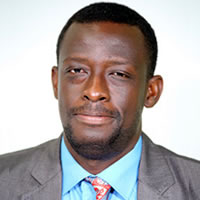Economic Activity Status by Sex
The activity status of the population five years and older is shown in Tables 9.1a and 9.1b. There are 2,042,645 persons in the age-group five years and older. Of these 51.6 percent are economically active. A breakdown by sex indicates a fairly even distribution between the sexes. For the age group under 25 years for the economically inactive, the percentage of males (26.1%) is slightly higher than that of females (25.5%). On the other hand the percentage of females is higher than that of males for age groups 25 years and older (Table 9.1a)
Economic Activity Status by Age
The legal minimum age for work is 15 years. Table 9.1a shows that children (persons aged 5 – 14 years) constitute 3.6 percent of the economically active population. For purposes of this report, the 4.6 percent economically active children will be described as “working children”.
The proportion of economically active persons increases with age and reaches a peak (40.5%) at age group 35–59. Although working children constituted a small proportion of the economically active, the data shows that 4.4 percent and 8.3 percent of those aged 5 – 9 and 10 – 14 respectively are economically active (Table 9.1b). The increasing proportion of the economically active by age observed in Table 9.1a is confirmed by the activity rates by age in Table 9.1b. These rates reach a peak of 90.8 percent for those within 35 - 59 years, and also reduce by about 58.5 percent for those aged 60 years and older. The reverse is true for the economically not active.
Economic Activity Status by Type of Locality
Of the total number of persons economically active in the region, 43.3 percent are in urban areas with the remaining 56.7% in rural areas.. In terms of the age composition of the economically active group, the proportions in urban areas are higher than those in rural areas for only two age groups (25 – 34 and 35 - 59). For the four remaining age groups, the proportions in rural areas are higher than those in urban areas.
The proportion of economically active for age group 5 – 9 in urban areas is 0.4 percent. Table 9.2b shows that at all ages, economic activity rates for the economically active are higher in rural areas than in urban places. However, economically not active rates are higher in rural areas for age groups 5 – 9 and 10 – 14.
Economic Activity Status by Districts
Tables 9.3a, b, and c show the economic activity status of persons 15 years and older by District and sex. For the entire Region, seven out of ten persons are economically active, while one out of three are not. Juaboso has the highest economically active rate of 83.8 percent while Ellembelle recorded the lowest rate of 59.0 percent. Ten districts recorded rates of over 70 percent while five (Jomoro, Nzema East, Sekondi-Takoradi Metro, Shama, and Tarkwa Nsuaem) all have values of over 60 percent. Some of the low activity rates are also found in more urbanized districts in the Region. The distribution of economic activity status by District and sex is given in Tables 9.3b and 9.3c. In all districts the proportion of males who are economically active is slightly higher than the females, the only exceptions being Sekondi and Takoradi sub-metros, where the reverse is true.
The Region has 4.1 percent of persons aged 15 years and over unemployed. Four Districts, namely, Ahanta West, Sekondi Takoradi Metro, Shama and Tarkwa Nsuaem Municipal, recorded values higher than the Regional figure, with Sekondi-Takoradi Metro having reported the highest value of 7.0 percent. Sefwi Akontombra (1.4%) and Juabeso (1.1%) have the lowest proportions. In the northern Districts, the proportion of unemployed males is lower than that of females, while proportion of unemployed males is higher in the southern Districts. Tarkwa Nsuaem, Prestea-Huni Valley and Wassa Amenfi East are the only exceptions to this general pattern.
Employed
The composition of employed persons by age is shown in Table 9.4a and the employment rates by age are given in Table 9.4b. The composition of employed persons by age is the same as that of the economically active. The proportions increase with age sharply among age 35 – 59 years and reduce drastically for persons 60 years and older. The proportions employed in age groups 25 – 34 and 35 – 59 in urban areas are higher than the proportions for the same age groups in rural areas. For all the other age groups, the proportions are higher in rural areas.Out of the 2,042,645 persons aged five years and above in the Region, 48.8 percent are employed. The employment rates by age in Table 9.4b shows an increasing rate with age and a massive drop after age group 35 - 59.
There are differentials by type of locality with rates higher at all ages in rural than in urban areas. Although a total of 66.3 percent persons aged 15 years and older are employed, only 62.9 percent worked during the seven days prior to the census. About 3 percent did not work but had a job to go back to. Employed persons by District are given for the population aged 15 years and older as shown in Table 9.5 below. Eleven Districts recorded employment rates higher than the Regional figure.
All the coastal Districts including Tarkwa Nsuaem reported employment rates lower than the Regional value. The lowest rate (57.1%) is recorded in SekondiTakoradi Metro while the highest rate (82.7%) is in Juaboso. With the exception of Shama, over 90 percent of all employed persons worked during the seven days prior to the census.
Unemployed
Unemployed persons by age and type of locality can be found in Tables 9.4a and 9.4b above. Of the total Regional population of 2,042,645 aged five years and older, 3.5 percent are unemployed. The majority of the unemployed persons (58.9%) are in urban areas. The proportion of the unemployed as a percentage of total population in the relevant age group is 47.9 percent in urban and 25.6 percent in rural areas.
Nearly 40 percent of unemployed persons are within age 15 – 24 years. There are 1,449,507 persons aged 15 years and older in the Region and 4.1 percent of them are unemployed. Over 80 percent of these are first time job seekers; this pattern is observed across the Districts. Unemployment is low in Juaboso (1.1%) and high in Sekondi-Takoradi Metro (7.0%). Eleven Districts also recorded unemployment rates below the regional figure.
Economically not Active
The distribution of the economically not active by age, sex, type of locality and District are shown in Tables 9.1a, 9.1b, 9.2a, 9.2b, 9.3a, 9.3b, and 9.7. About 48 percent of persons five years and older are economically not active with more females (51.1%) than males (48.9%). Within age groups, the rate for the economically not active declines with increasing age with the exception of those who are 60 years and older. In terms of the age composition of the economically not active, the proportions in the two youngest age groups (5-9 and 10-14 years) were lower in urban (49.3%) than in rural (61.5%) areas, while the reverse was true for all other age groups (Table 9.2a). This observation still holds for rates within age groups as shown in Table 9.2b.
The economically not active by District and sex are shown in Tables 9.3a, 9.3b and 9.3c. The regional figure is 29.6 percent of persons aged 15 years and older. Eleven districts had rates below this figure. Juaboso (16.2%) recorded the lowest while Ellembelle (41.0%) had the highest rate. Economically not active rates for the Region are 27.9 percent for males and 31.1 percent for females. This higher rate for females is consistent across most Districts except for Ahanta West where the rate is the same (24.3%) for both male and females. The largest differential of females over males is reported by Prestea Huni Valley (7.6%), Aowin/ Suaman (6.8%) and Tarkwa Nsuaem (6.6%). Table 9.7 provides reasons for the economically not active by District. The main reasons given for being economically not active are engaged as students, homemakers and too old/too young to work.
Occupation
In the Western Region as well as in all its Districts except Sekondi-Takoradi Metro, skilled agricultural, forestry and fishery workers constitutes the largest occupational group, accounting for over 70 percent of occupations in four districts – SefwiAkomtombra (86.5%), Juaboso (79.9%), Aowin/Suaman (79.9%) and Bia (75.8%). Service and sales workers are the second largest group in the Region.
Sekondi-Takoradi Metropolis which is the most urbanized District in the Region, service and sales workers constitute is the dominant occupational group (32.7%), while craft and related trades workers (22.2%) are the second largest. Females dominate the service and sales workers while males dominate plant and machine operators and assemblers, technicians and associate professionals, and professionals groups. Males have a slight edge over females in the skilled agricultural, forestry and fishery workers, and clerical support workers groups.
Industry
Agriculture, (including forestry and fishing) is the major industry in the Region (47.5%), accounting for the largest proportion of employed persons in all Districts except Sekondi-Takoradi metropoplis. The sector employs over 70 percent of employed persons in four Districts, SefwiAkomtombra (85.8%), Juabeso (79.9%), Aowin/Suaman (79.2%) and Bia (75.5%). Wholesale and retail; repair of motor vehicles and motorcycles is the second largest industry in the Region and also in 13 Districts.
It is the most important industry in the Sekondi-Takoradi metropolis employing about 1 in 3 persons. Mining and quarrying is the second largest employer in TarkwaNsuaem (22.6%) and Prestea/Huni valley (18.2%). Males dominate in mining and quarrying, construction, transportation and storage, professional and technical activities and administrative and support service activities while females also dominate in wholesale and retail and accommodation and food service activities.
Employed Persons 15 years and Older by Employment Status
The employment status of persons 15 years and older is shown in Table 9.10. The self-employed (without employees) is the largest category in the Region (59.3%) as well as in all Districts. The proportion self employed without employees is over 60 percent in most (13 out of 17) Districts, with Ellembelle (69.0%) having the highest and Sekondi-Takoradi Metro (47.2%) the lowest. Females dominate the males in most Districts (12) in this category. The self-employed with employees contribute less than five percent in all Districts except Sekondi-Takoradi Metropolis (6.5%) and Bia (5.0%). Males dominate this category in all Districts.
The more urbanized districts in the region have a relatively higher proportion of persons who are employees than the less urbanized ones - Sekondi-Takoradi Metropolis (36.6%) Tarkwa Nsuaem (25.8%), Shama (21.0%). Males also dominate the employee category. Contributing family worker is the second largest category in eight Districts with proportions ranging from a low of 12.9 percent in Sefwi-Bibiani-Anhwiaso-Bekwai to a high of 29.6 percent Juaboso. Females dominate this group in all Districts.
Employment Sector
Six categories are provided for sector of employment, namely, public/government, private formal, private informal, semi-public/parastal, NGOs (local and international) and other international organizations. The private informal sector accounts for over 80 percent in all districts except Sekondi-Takoradi Metropolis (69.3%) and Tarkwa Nsuaem (78.9%). Females dominate this sector. The public (6.2%) and private formal (7.6%) sectors contribute relatively, significant numbers to employment of persons 15 years and older for the Region as well as the Districts. The proportions of employed in private formal sector is particularly important in Sekondi-Takoradi Metropolis and Tarkwa/Nsuaem, employing 15.3 percent and 16.7 percent respectively. Males dominate employment in both sectors in all Districts.
Date Created : 12/18/2017 4:45:44 AM





 facebook
facebook X (twitter)
X (twitter) Youtube
Youtube +233 593 831 280
+233 593 831 280 0800 430 430
0800 430 430 GPS: GE-231-4383
GPS: GE-231-4383 info@ghanadistricts.com
info@ghanadistricts.com Box GP1044, Accra, Ghana
Box GP1044, Accra, Ghana